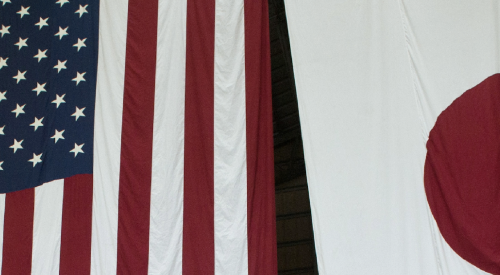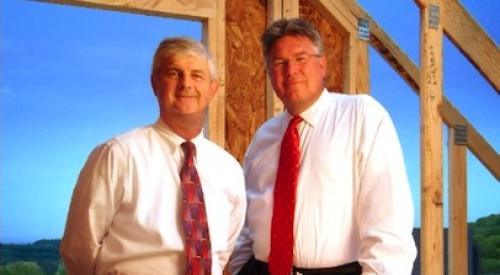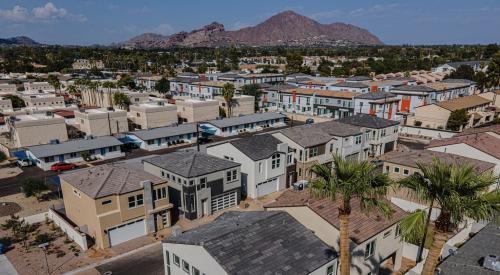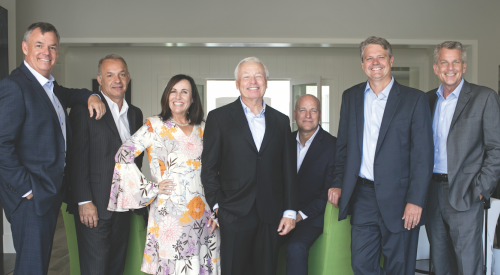|
To reach the corporate headquarters of Shea Homes in Walnut, Calif., — the jewel in the crown of the J.F. Shea Co., — you must face the perilous gridlock of Southern California's freeways; the dust and detours of road construction; and all of the other fast-paced pressures of modern life in the fast lanes. Once you walk through Shea's doors, however, you feel like you're home with friends.
The sense of personal relationship with the company's employees is no accident. It's a large part of their corporate creed: the psychological bedrock upon which they have built their reputation — and their construction empire.
"We're concerned with keeping the company's family values and living by those values," notes Bert Selva, CEO and president of Shea Homes, who joined the company 10 years ago. "It begins and ends with honesty and integrity."
Those high-minded ideals, of course, are a familiar mantra in the business world. But the real test is whether a firm actually lives its values. Shea tackles that challenge with a high-tech and a "high-touch" perspective: it uses number-crunching software to benchmark "soft" goals, such as employee morale, customer satisfaction and company cultural fit. At the same time, Shea's corporate philosophy still keeps personal contact high on the priority list.
For these reasons and others, Professional Builder has chosen Shea Homes as the Builder of the Year for 2007. A large, private company, Shea builds more than 6,000 homes a year in eight divisions across the Western United States, along with one self-contained division in North Carolina. The home-building arm of J.F. Shea Co. also includes Shea Financial Services, a mortgage firm that services about 71 percent of Shea's new home sales.
 Shea Homes executives. From back to front: Robb Pigg, Eric Snider, Terry Bryan and Bert Selva. |
Despite the emphasis on people, this isn't a loosely run firm. The execution — not just the rhetoric — of family values actually plays into the hierarchy of friendly competition within the parent company.
That includes upper management. For example, the company has been conducting very specific surveys of employees for years that ask them how their supervisors perform. The results of those surveys are then ranked. If you're at the bottom of the list, you may get called in for some coaching.
"It's not so hard-core that people feel they're being ranked all the time," Selva notes. "But it gives us a good perspective on how the organization is working."
He adds that Shea emphasizes two major employee traits: commitment and alignment to the organization's goals. Surveys such as this one can tell whether people are really living by the company's values — respecting other employees, for example.
"You can get people who are very committed to the organization," he explains, "but they may not know where the company is going."
The Driver's SeatShea has developed a custom software program they call "the dashboard." The inner workings are a closely guarded secret.
What Selva will say is that putting this managerial software into action required a major overhaul of Shea's bureaucracy.
"We used to have as many as 450 different reports that had to be entered," Selva recalls "We consolidated that number down to about 60, which are really integrated well."
That data is put into a deceptively simple looking computer screen consisting of a half-dozen simple dials resembling speedometers. But instead of tracking highway speed, these dials reflect real data from all eight of Shea's divisions, collected in real time. At a glance, any division manager can check in on any other division and compare progress for a number of key indicators, including on-time closings, percent of sales from referrals, accident frequency and sales versus units available.
Selva believes all of Shea's divisions should be measured by the same standards (with the exception of product design) despite regional and market differences. Divisions whose numbers are lagging, he says, won't get taken to the woodshed, but they will know it's time to evaluate methods and marketing.
"What [the dashboard] really does is triggers dialogue," Selva explains. "For example, if sales are not keeping pace with construction, we ask whether they were too optimistic in their sales planning."
'Collegial' LieutenantsDespite the pressure of constant side-by-side benchmarking of their performance, Shea's division heads say they don't feel unrealistic pressures.
"The company really gives us a lot of autonomy and the leeway we need to be successful," notes Rick Andreen, president of the Active Adult division based in Scottsdale, Ariz. "The culture of the company isn't to go and beat someone over the head if they're not doing well in a certain area.
"I've never felt a rivalry between the divisions, and I've been here eight years," he adds. "I have a very collegial relationship with all of the other division managers. We don't really compete for resources."
Andreen also can speak knowledgeably about what separates Shea from the larger, public builders. He used to work for two of the largest in the country.
"At the end of the day, as a private company, we can act with a longer term horizon," he says. "We don't need to do things that make our numbers look good for January. If accelerating a land purchase makes this year's numbers look worse, but promises better long term results, we can do that. I've seen public builders buy extra units that they know are not going to be profitable just so they can hit the numbers they promised."
"I have a direct relationship with the company owners," he adds. "A public firm can't possibly know all of its 13,000 shareholders."
At the same time, he says, his team members share an indirect sense of connection with the Shea family.
"I think the most important thing to understand about Shea is that we get the best of both worlds. We're a family-owned business and a big corporation. People don't like doing business with big corporations, but they do like the stability a corporation offers. The fact that we're also a family business makes the corporate aspect acceptable."
Shea's San Diego division earned a National Housing Quality award this year. It won the same award 10 years ago. And it's not alone. Shea's Arizona and Colorado divisions have also won the prestigious award in recent years.
"We look at where we were 10 years ago when we won that award," says San Diego division president Paul Barnes, "and we're light years ahead of that mark today."
Barnes notes that his division implemented Total Quality Management principles in 1991 and reduced defects by 80 percent. It's building between 500 and 700 new homes a year.
"The numbers are important," Barnes adds, "but we can still take the risk. You just tell [the company's top brass], 'Here's what we want to change,' and you'll get the support you need."
Barnes adds that this sense of trust from corporate allows his division to take on relatively small projects — an important flexibility as land becomes scarce.
"Sometimes it's hard to fit into the Rubik's cube of local entitlements," he says. "We've got a couple of years [land] supply here in San Diego. The smallest is about 67 homes, but it's a block from the ocean. Part of why we take a project is because we love what we do. We want to do stuff that's fun. So sometimes we'll take a 40-home community if it plays to our strength.
"Our employees come at the business from the perspective of customer satisfaction," Barnes continues. "That's part of the culture, and we've been practicing it long enough that it's paying dividends for us. We'll continue to fine-tune the buyer experience."
Market ChameleonLike most highly successful companies, Shea responds quickly to market changes. It's known as an innovator, not just in terms of building homes but also in its marketing.
Case in point: a serious housing slowdown that's rippling across the Southwest. In response, Shea's Southern California division just launched a campaign that helps home buyers sell their existing homes.
Eric Snider, vice president of sales and marketing, exemplifies the company's efforts to unify operations across divisions.
"I'm charged with shepherding the brand — maintaining brand integrity," he explains. "The divisions really handle local advertising buys; that's where most of the advertising budget goes. We spend about 10 percent on national buys, such as the Wall Street Journal."
Snider adds, however, that Shea's marketing effort "is not a strict hierarchy." Divisions often market outside of the brand, particularly in a master planned community involving several builders.
A tougher sales market has shifted the focus in recent months. The company has gone back to a more local model, he says, where divisions are encouraged to try innovative marketing ideas all the way down to the subdivision level. "For example, Active Adult is trying something: a guaranteed price. They've found that these clients are very aware of price variations. The way it works is if we close on their unit and change (lower) the base price of that unit within 90 days of the closing, we give them back the money they would have saved."
Shea often taps synergies across divisions, linking their mortgage company to marketing plans, for example. "We're working on a retailing message to get an interest rate that will infuse some interest," Snider says. To make that happen, Shea Financial Services bought a "compelling rate" that Snider believes will entice buyers.
Some moves are less dramatic but equally unexpected. For example, the company introduced four-car garages in Phoenix and made a bang. But Shea doesn't innovate for the sake of change, Selva notes. Like most builders, it follows the customer's lead.
"Whatever we do has to create added value in the customer's mind," Selva says.
On the other hand, he says, as a private company, Shea doesn't have to chase volume. And as a result, Shea's divisions often set themselves apart by saying no to the latest big builder craze.
"For instance, a lot of the big builders are doing high-rise towers," Selva explains. "We chose not to get into that business now, because you can't close one unit at time, which is how we like to build. If the market slows and we need to slow starts, we can do it. We don't have Wall Street people calling us, pressuring us."
Snider notes that Shea's marketing isn't just about selling homes in the here and now. It's about sustainability.
"Half of my job is looking at the future, deciding which markets we want to move into," he explains. "We look at where and how people live today and do extensive surveying. We want to understand what the motivational drivers are."
Snider says he's currently looking closely at Florida, evaluating Shea's plan for a new division there.
The Long ViewDespite the market slowdown, there's little doubt that Shea will ride out the slide and possibly emerge even stronger. That's been its pattern for 125 years. Paradoxically, the secret to that success has come from its focus on the future, not dependence on an illustrious past. Side by side with the people-focused culture of the company is a sharp, no-nonsense corporate approach to balance.
Selva says he receives a monthly letter from each division president that summarizes specifics of the division. "Our sales people are telling us that traffic is down, but at the same time the quality of buyers is up," Selva says.
The construction business tends to balance in other ways, too.
How important is the company's 125-year legacy? That depends on what you emphasize, says Andreen.
"We did a study on the subject," he says. "We found out that once your building company longevity gets beyond 30 or 40 years, customers don't care if you're Centex, Pulte or Shea."
They do pay heed, he adds, when they learn about Shea's work on landmark projects. "They like to hear that we worked on the Hoover Dam or the Golden Gate Bridge, or that we have a tunneling business 900 feet under Manhattan island."
Selva adds that during his job interview, he asked Shea's owners "point blank" about whether they had plans to sell the company to a public builder in the near future.
"You should have seen the look they gave me," he recalls. "I realized then that the Shea family really cares about their legacy and their good name as much as they do about making money. They still get excited about new ideas. I don't see them making any big changes."
"Tomorrow is more important than yesterday," Selva continues. "Fifty years from now, I'd like people to look back and say we made a difference. We enhanced a lot of peoples' lives — not just our customers — but also our employees."
|


















